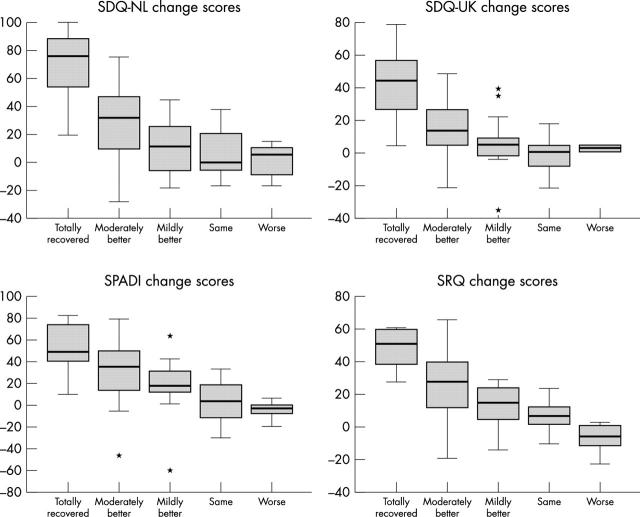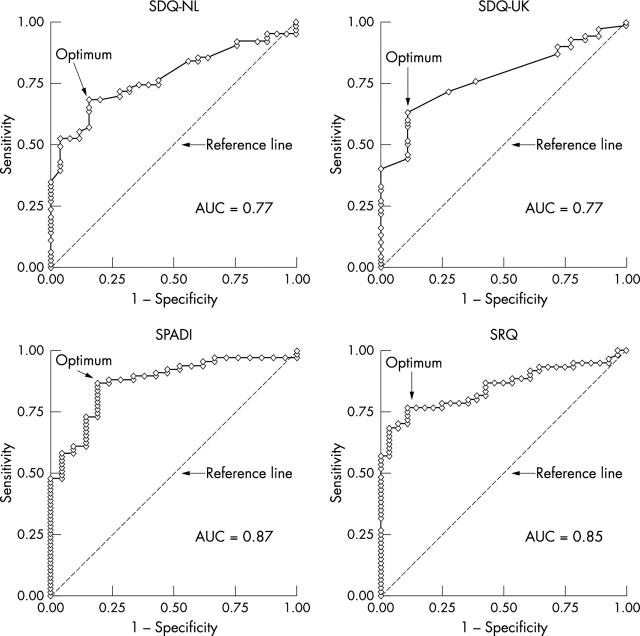Abstract
Objectives: To compare the validity, responsiveness to change, and user friendliness of four self completed, shoulder-specific questionnaires in primary care.
Methods: A cross sectional assessment of validity and a longitudinal assessment of responsiveness to change of four shoulder questionnaires was carried out: the Dutch Shoulder Disability Questionnaire (SDQ-NL); the United Kingdom Shoulder Disability Questionnaire (SDQ-UK); and two American instruments, the Shoulder Pain and Disability Index (SPADI) and the Shoulder Rating Questionnaire (SRQ). 180 primary care consulters with new shoulder region pain each completed two of the questionnaires, as well as EuroQoL and 10 cm visual analogue scales (VAS) for overall pain and difficulty due to the shoulder problem. Each participant was assessed by a standardised clinical schedule. Postal follow up at 6 weeks included baseline measures and self rated assessment of global change of the shoulder problem (seven point Likert scale).
Results: Strongest correlations were found for SDQ-UK with EuroQoL 5 score, and for SPADI and SRQ with shoulder pain and difficulty VAS. All shoulder questionnaires correlated poorly with active movement at the painful shoulder. SPADI and SRQ performed better on ROC analysis than SDQ-NL and SDQ-UK (areas under the curve of 0.87, 0.85, 0.77, and 0.77, respectively). However, SRQ scores changed significantly over time in stable subjects.
Conclusions: Cross sectional comparison of the four shoulder questionnaires showed they had similar overall validity and patient acceptability. SPADI and SRQ were most responsive to change. Additionally, SPADI was the quickest to complete and scores did not change significantly in stable subjects.
Full Text
The Full Text of this article is available as a PDF (179.2 KB).
Figure 1.
Box plots of the distribution of change scores for the shoulder questionnaires in relation to categories of self rated change.
Figure 2.
ROC curves of the shoulder questionnaires against self rated change (improved or not improved).
Selected References
These references are in PubMed. This may not be the complete list of references from this article.
- Beaton D. E., Richards R. R. Measuring function of the shoulder. A cross-sectional comparison of five questionnaires. J Bone Joint Surg Am. 1996 Jun;78(6):882–890. doi: 10.2106/00004623-199606000-00011. [DOI] [PubMed] [Google Scholar]
- Beaton D., Richards R. R. Assessing the reliability and responsiveness of 5 shoulder questionnaires. J Shoulder Elbow Surg. 1998 Nov-Dec;7(6):565–572. doi: 10.1016/s1058-2746(98)90002-7. [DOI] [PubMed] [Google Scholar]
- Croft P. Measuring up to shoulder pain. Ann Rheum Dis. 1998 Feb;57(2):65–66. doi: 10.1136/ard.57.2.65. [DOI] [PMC free article] [PubMed] [Google Scholar]
- Croft P., Pope D., Zonca M., O'Neill T., Silman A. Measurement of shoulder related disability: results of a validation study. Ann Rheum Dis. 1994 Aug;53(8):525–528. doi: 10.1136/ard.53.8.525. [DOI] [PMC free article] [PubMed] [Google Scholar]
- Dawson J., Fitzpatrick R., Carr A. Questionnaire on the perceptions of patients about shoulder surgery. J Bone Joint Surg Br. 1996 Jul;78(4):593–600. [PubMed] [Google Scholar]
- Felson D. T., Meenan R. F., Dayno S. J., Gertman P. Referral of musculoskeletal disease patients by family and general practitioners. Arthritis Rheum. 1985 Oct;28(10):1156–1162. doi: 10.1002/art.1780281012. [DOI] [PubMed] [Google Scholar]
- Green S., Buchbinder R., Glazier R., Forbes A. Systematic review of randomised controlled trials of interventions for painful shoulder: selection criteria, outcome assessment, and efficacy. BMJ. 1998 Jan 31;316(7128):354–360. doi: 10.1136/bmj.316.7128.354. [DOI] [PMC free article] [PubMed] [Google Scholar]
- Guyatt G., Walter S., Norman G. Measuring change over time: assessing the usefulness of evaluative instruments. J Chronic Dis. 1987;40(2):171–178. doi: 10.1016/0021-9681(87)90069-5. [DOI] [PubMed] [Google Scholar]
- Hanley J. A., McNeil B. J. The meaning and use of the area under a receiver operating characteristic (ROC) curve. Radiology. 1982 Apr;143(1):29–36. doi: 10.1148/radiology.143.1.7063747. [DOI] [PubMed] [Google Scholar]
- Heald S. L., Riddle D. L., Lamb R. L. The shoulder pain and disability index: the construct validity and responsiveness of a region-specific disability measure. Phys Ther. 1997 Oct;77(10):1079–1089. doi: 10.1093/ptj/77.10.1079. [DOI] [PubMed] [Google Scholar]
- Husted J. A., Cook R. J., Farewell V. T., Gladman D. D. Methods for assessing responsiveness: a critical review and recommendations. J Clin Epidemiol. 2000 May;53(5):459–468. doi: 10.1016/s0895-4356(99)00206-1. [DOI] [PubMed] [Google Scholar]
- Kazis L. E., Anderson J. J., Meenan R. F. Effect sizes for interpreting changes in health status. Med Care. 1989 Mar;27(3 Suppl):S178–S189. doi: 10.1097/00005650-198903001-00015. [DOI] [PubMed] [Google Scholar]
- Kind P., Dolan P., Gudex C., Williams A. Variations in population health status: results from a United Kingdom national questionnaire survey. BMJ. 1998 Mar 7;316(7133):736–741. doi: 10.1136/bmj.316.7133.736. [DOI] [PMC free article] [PubMed] [Google Scholar]
- Kohn D., Geyer M. The subjective shoulder rating system. Arch Orthop Trauma Surg. 1997;116(6-7):324–328. doi: 10.1007/BF00433982. [DOI] [PubMed] [Google Scholar]
- L'Insalata J. C., Warren R. F., Cohen S. B., Altchek D. W., Peterson M. G. A self-administered questionnaire for assessment of symptoms and function of the shoulder. J Bone Joint Surg Am. 1997 May;79(5):738–748. [PubMed] [Google Scholar]
- Liang M. H., Fossel A. H., Larson M. G. Comparisons of five health status instruments for orthopedic evaluation. Med Care. 1990 Jul;28(7):632–642. doi: 10.1097/00005650-199007000-00008. [DOI] [PubMed] [Google Scholar]
- Michener L. A., Leggin B. G. A review of self-report scales for the assessment of functional limitation and disability of the shoulder. J Hand Ther. 2001 Apr-Jun;14(2):68–76. doi: 10.1016/s0894-1130(01)80036-3. [DOI] [PubMed] [Google Scholar]
- Pope D. P., Croft P. R., Pritchard C. M., Silman A. J. Prevalence of shoulder pain in the community: the influence of case definition. Ann Rheum Dis. 1997 May;56(5):308–312. doi: 10.1136/ard.56.5.308. [DOI] [PMC free article] [PubMed] [Google Scholar]
- Roach K. E., Budiman-Mak E., Songsiridej N., Lertratanakul Y. Development of a shoulder pain and disability index. Arthritis Care Res. 1991 Dec;4(4):143–149. [PubMed] [Google Scholar]
- Roddey T. S., Olson S. L., Cook K. F., Gartsman G. M., Hanten W. Comparison of the University of California-Los Angeles Shoulder Scale and the Simple Shoulder Test with the shoulder pain and disability index: single-administration reliability and validity. Phys Ther. 2000 Aug;80(8):759–768. [PubMed] [Google Scholar]
- Van der Schouw Y. T., Verbeek A. L., Ruijs J. H. ROC curves for the initial assessment of new diagnostic tests. Fam Pract. 1992 Dec;9(4):506–511. doi: 10.1093/fampra/9.4.506. [DOI] [PubMed] [Google Scholar]
- Williams J. W., Jr, Holleman D. R., Jr, Simel D. L. Measuring shoulder function with the Shoulder Pain and Disability Index. J Rheumatol. 1995 Apr;22(4):727–732. [PubMed] [Google Scholar]
- van der Heijden G. J., Leffers P., Bouter L. M. Shoulder disability questionnaire design and responsiveness of a functional status measure. J Clin Epidemiol. 2000 Jan;53(1):29–38. doi: 10.1016/s0895-4356(99)00078-5. [DOI] [PubMed] [Google Scholar]
- van der Windt D. A., van der Heijden G. J., de Winter A. F., Koes B. W., Devillé W., Bouter L. M. The responsiveness of the Shoulder Disability Questionnaire. Ann Rheum Dis. 1998 Feb;57(2):82–87. doi: 10.1136/ard.57.2.82. [DOI] [PMC free article] [PubMed] [Google Scholar]




